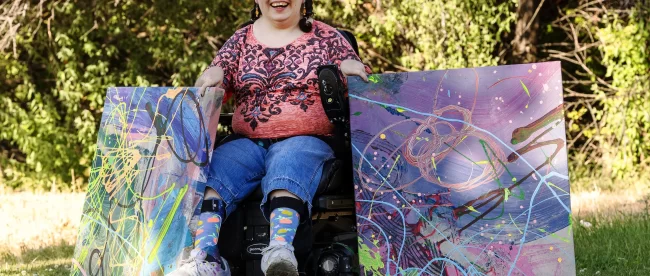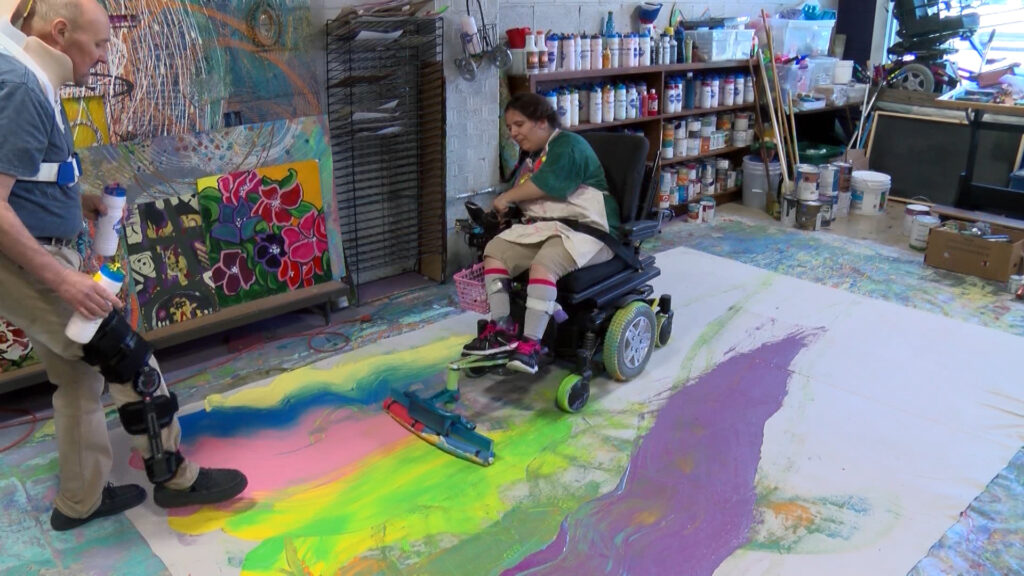Jump the Moon: Empowering Artistic Inclusivity with Adaptive Technology
 Kaya Eccles smiles as she poses for photos with two of her paintings in Logan on Wednesday, July 12, 2023 (Image Source: Deseret News)
Kaya Eccles smiles as she poses for photos with two of her paintings in Logan on Wednesday, July 12, 2023 (Image Source: Deseret News)
Jump the Moon is a nonprofit art studio based in Cache Valley, Utah, founded by Michael Bingham. The studio’s main focus is on providing a creative space for Utah artists with disabilities. Michael, a former art teacher, was motivated to start the studio after realizing the potential of adaptive technology to help disabled students express themselves through art. One of the studio’s artists, Kaya Eccles, who has muscular dystrophy, uses adaptive painting tools designed by Michael to create her artwork.
Michael’s journey started with creating a wooden attachment for Kaya’s power wheelchair, allowing her to control pencils and markers to draw. Witnessing Kaya’s joy and the desire of other students to create art in a similar way, he expanded his efforts to develop more adaptive tools. These tools include a specially-built power wheelchair for painting, a painting pendulum, and a spin art machine, all designed to make art accessible and enjoyable for artists with disabilities.

Over the years, Jump the Moon has grown, showcasing the creative work of disabled Utah artists in monthly galleries. They have also extended their outreach to assisted living centers, collaborating with residents to create art. Despite facing challenges, such as a serious accident that Michael survived, the studio has persevered with the support of dedicated volunteers.
Watch the videos below to learn more about Jump The Moon, Michael Bingham, annd Kaya Eccles.
Lessons From Jump The Moon
- Inclusivity and Adaptive Technology: Jump the Moon’s success shows the power of inclusivity and adaptive technology in the world of art. By providing accessible tools and a supportive environment, artists with disabilities can express themselves creatively and achieve remarkable results. Embracing adaptive technology can empower individuals with diverse abilities to participate fully in creative endeavors.
- Creating Opportunities: Michael Bingham’s journey from being an art teacher to founding Jump the Moon highlights the impact of creating opportunities for individuals who may need extra support or encouragement. By identifying and addressing the needs of artists with disabilities, we can open doors for their artistic growth and enrich the art community with their unique perspectives.
- Perseverance and Resilience: The challenges faced by Jump the Moon, including a near-fatal accident for the founder, demonstrate the importance of perseverance and resilience in pursuing a meaningful cause. Nonprofits and organizations focused on making a positive impact may encounter obstacles, but with determination and dedicated support from volunteers, they can continue to thrive.
- Community Support: Jump the Moon’s success and continuity have been possible through the help of dedicated volunteers and community support. Building a strong network of supporters who recognize the value of the organization’s mission can make a significant difference in its long-term sustainability.
- Inspiring Creativity: The name “Jump the Moon” reflects the belief that art can transcend perceived limitations and enable anyone to achieve the extraordinary. This concept encourages artists and creators to think beyond traditional boundaries and explore innovative ways to express themselves creatively.
- Art for All: The studio’s mission to extend its outreach to assisted living centers highlights the significance of art as a universal language. Engaging individuals of all abilities in artistic pursuits can bring joy and fulfillment to their lives and reinforce the idea that everyone is capable of contributing creatively to the world.
In conclusion, Jump the Moon serves as an inspiring example of how art can be a catalyst for inclusivity and empowerment. By embracing adaptive technology, providing opportunities, and fostering a supportive community, we can create a more inclusive and enriched artistic landscape where everyone has the chance to shine.
Source: Deseret News
This blog was written mostly using chatGPT, a potential tool for increased accessibility. Do you think this is an appropriate use of chatGPT? Why or why not? Let me know!

Leave a comment